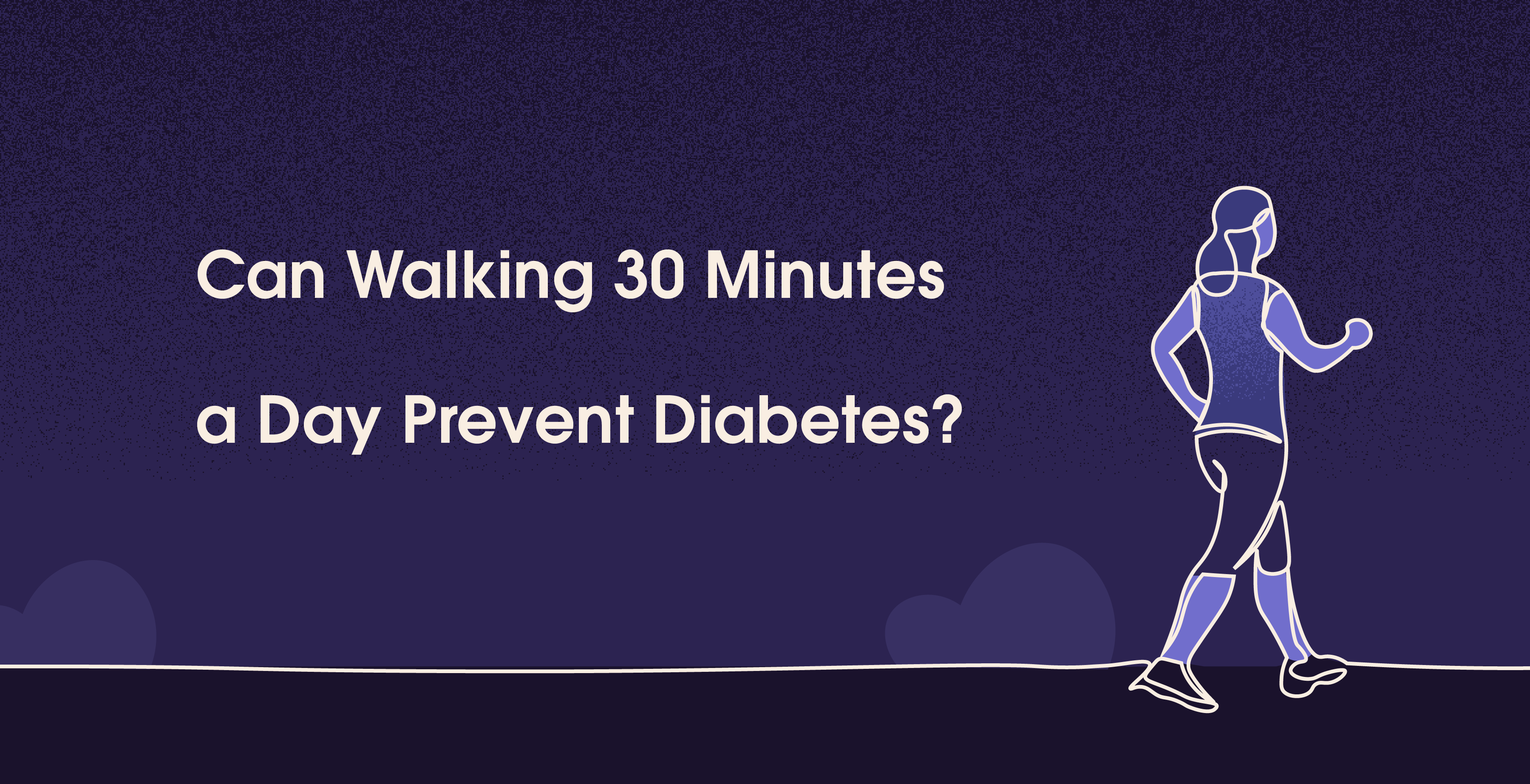Can Walking 30 Minutes a Day Prevent Diabetes?
Jan 31, 2025
Sayfali Rawlani



Table Of Contents
We’ve all heard it before—“Get some exercise, it’s good for you!” But can something as simple as walking for half an hour daily actually prevent diabetes? Sounds too good to be true, right? Well, let’s take a little stroll through this idea and unpack it.
Highlights
Walking is an accessible, underrated form of exercise requiring no fancy equipment.
Regular walking improves insulin sensitivity, helping regulate blood sugar levels and lowering the risk of diabetes.
It also reduces stress by releasing endorphins, which helps control blood sugar indirectly.
A 30-minute daily walk strikes the right balance for improving circulation, engaging muscles, and boosting insulin efficiency.
Walking has additional health benefits, including lowering blood pressure, improving heart health, and burning calories.
Consistency is key—daily walks or splitting the 30 minutes into shorter sessions works effectively.
Walking routines can be flexible—solo, with family, or while enjoying music or podcasts.
It’s a sustainable lifestyle change that complements other efforts like a balanced diet and stress management.
Although not a guaranteed solution, walking significantly reduces risk factors for diabetes and promotes overall well-being.
Walking is a simple, powerful act of self-care with long-term health benefits.
Walking
When people think about exercise, their minds often jump straight to intense workouts—lifting weights, running marathons, or sweating buckets in a spin class. But walking? It’s kind of like the wallflower at the fitness party. Understated and often overlooked, it quietly holds its own charm. You don’t need fancy gym equipment or a membership to a posh club. A pair of comfy shoes and a bit of open space, and you’re good to go.
But does walking pack enough punch to fend off a heavy-hitter like diabetes? Turns out, yes, it just might.
A Chain Reaction of Benefits
When you lace up your sneakers and step outside, your body starts a ripple effect. Your heart rate picks up, your muscles get moving, and—here’s the kicker—your cells become more sensitive to insulin. Think of it like your body’s way of hitting the refresh button. Insulin, that little hormone responsible for regulating your blood sugar, suddenly has an easier time doing its job.
Over time, this regular movement can lower your blood sugar levels, reduce insulin resistance, and—drumroll, please—help keep diabetes at bay. All without breaking a sweat.
A Mental Boost to Sweeten the Deal
The perks of walking aren’t all physical, though. It’s also a sneaky little mood booster. Ever noticed how a quick walk can clear your head after a long day? That’s your brain releasing those feel-good endorphins, the unsung heroes of mental health. Stress, as it happens, plays a huge role in spiking blood sugar levels. So, by keeping your mind calm and your stress in check, walking is pulling double duty.
The 30-Minute Sweet Spot
Now, you might be wondering—why 30 minutes? Why not 15? Or an hour? Here’s the thing: half an hour strikes the perfect balance. It’s long enough to get your blood circulating, your muscles engaged, and your insulin sensitivity nudged in the right direction. But it’s also short enough to squeeze into a busy day.
A morning stroll to start the day, a midday break to recharge, or an evening walk to unwind—it fits wherever you need it.
Beyond Blood Sugar
Let’s not forget the ripple effects beyond diabetes prevention. Walking lowers blood pressure, strengthens your heart, and even burns calories. And while we’re on the subject, let’s not underestimate the power of a little fresh air and sunshine. It’s like giving your body and mind a mini-vacation.
The Key Is Consistency
Walking isn’t a one-and-done deal. It’s the kind of habit that needs to be nurtured over time. Think of it as a slow-brewed cup of tea, not an instant coffee. A 30-minute stroll once a week? Nice, but not quite enough. Daily commitment, however, can work wonders.
Even if you can’t carve out a full half-hour in one go, splitting it into two or three shorter walks still gets the job done. The point is to keep moving.
A Walking Routine You’ll Actually Stick To
The beauty of walking is its flexibility. You can do it solo, with a friend, or even while chatting on the phone. Mix up your routes—stroll through a park one day, explore your neighborhood the next. Listen to music, catch up on a podcast, or just let your thoughts wander.
It’s also a great excuse to bond with family. Make it a group activity. Even your dog will thank you for it.
The Bigger Picture
Walking isn’t some magic wand that guarantees you’ll never develop diabetes. Genetics, diet, and other lifestyle factors all play a role. But by incorporating daily walks into your routine, you’re giving yourself a fighting chance. It’s a small, sustainable step in the right direction, and honestly, we could all use more of those.
So, the next time you’re tempted to skip that walk, remind yourself it’s more than just exercise. It’s an investment in your future health, a quiet rebellion against a sedentary lifestyle, and a simple act of self-care.
The Bottom Line
Walking 30 minutes a day may not sound groundbreaking, but it’s a game-changer. It’s the kind of habit that sneaks up on you, improving your health in ways you didn’t even realize. And hey, if it helps keep diabetes at bay, isn’t it worth a shot?
So, throw on your sneakers, step outside, and start moving. Your body—and your future self—will thank you. Who knew such a simple act could have such a big impact?
References
We’ve all heard it before—“Get some exercise, it’s good for you!” But can something as simple as walking for half an hour daily actually prevent diabetes? Sounds too good to be true, right? Well, let’s take a little stroll through this idea and unpack it.
Highlights
Walking is an accessible, underrated form of exercise requiring no fancy equipment.
Regular walking improves insulin sensitivity, helping regulate blood sugar levels and lowering the risk of diabetes.
It also reduces stress by releasing endorphins, which helps control blood sugar indirectly.
A 30-minute daily walk strikes the right balance for improving circulation, engaging muscles, and boosting insulin efficiency.
Walking has additional health benefits, including lowering blood pressure, improving heart health, and burning calories.
Consistency is key—daily walks or splitting the 30 minutes into shorter sessions works effectively.
Walking routines can be flexible—solo, with family, or while enjoying music or podcasts.
It’s a sustainable lifestyle change that complements other efforts like a balanced diet and stress management.
Although not a guaranteed solution, walking significantly reduces risk factors for diabetes and promotes overall well-being.
Walking is a simple, powerful act of self-care with long-term health benefits.
Walking
When people think about exercise, their minds often jump straight to intense workouts—lifting weights, running marathons, or sweating buckets in a spin class. But walking? It’s kind of like the wallflower at the fitness party. Understated and often overlooked, it quietly holds its own charm. You don’t need fancy gym equipment or a membership to a posh club. A pair of comfy shoes and a bit of open space, and you’re good to go.
But does walking pack enough punch to fend off a heavy-hitter like diabetes? Turns out, yes, it just might.
A Chain Reaction of Benefits
When you lace up your sneakers and step outside, your body starts a ripple effect. Your heart rate picks up, your muscles get moving, and—here’s the kicker—your cells become more sensitive to insulin. Think of it like your body’s way of hitting the refresh button. Insulin, that little hormone responsible for regulating your blood sugar, suddenly has an easier time doing its job.
Over time, this regular movement can lower your blood sugar levels, reduce insulin resistance, and—drumroll, please—help keep diabetes at bay. All without breaking a sweat.
A Mental Boost to Sweeten the Deal
The perks of walking aren’t all physical, though. It’s also a sneaky little mood booster. Ever noticed how a quick walk can clear your head after a long day? That’s your brain releasing those feel-good endorphins, the unsung heroes of mental health. Stress, as it happens, plays a huge role in spiking blood sugar levels. So, by keeping your mind calm and your stress in check, walking is pulling double duty.
The 30-Minute Sweet Spot
Now, you might be wondering—why 30 minutes? Why not 15? Or an hour? Here’s the thing: half an hour strikes the perfect balance. It’s long enough to get your blood circulating, your muscles engaged, and your insulin sensitivity nudged in the right direction. But it’s also short enough to squeeze into a busy day.
A morning stroll to start the day, a midday break to recharge, or an evening walk to unwind—it fits wherever you need it.
Beyond Blood Sugar
Let’s not forget the ripple effects beyond diabetes prevention. Walking lowers blood pressure, strengthens your heart, and even burns calories. And while we’re on the subject, let’s not underestimate the power of a little fresh air and sunshine. It’s like giving your body and mind a mini-vacation.
The Key Is Consistency
Walking isn’t a one-and-done deal. It’s the kind of habit that needs to be nurtured over time. Think of it as a slow-brewed cup of tea, not an instant coffee. A 30-minute stroll once a week? Nice, but not quite enough. Daily commitment, however, can work wonders.
Even if you can’t carve out a full half-hour in one go, splitting it into two or three shorter walks still gets the job done. The point is to keep moving.
A Walking Routine You’ll Actually Stick To
The beauty of walking is its flexibility. You can do it solo, with a friend, or even while chatting on the phone. Mix up your routes—stroll through a park one day, explore your neighborhood the next. Listen to music, catch up on a podcast, or just let your thoughts wander.
It’s also a great excuse to bond with family. Make it a group activity. Even your dog will thank you for it.
The Bigger Picture
Walking isn’t some magic wand that guarantees you’ll never develop diabetes. Genetics, diet, and other lifestyle factors all play a role. But by incorporating daily walks into your routine, you’re giving yourself a fighting chance. It’s a small, sustainable step in the right direction, and honestly, we could all use more of those.
So, the next time you’re tempted to skip that walk, remind yourself it’s more than just exercise. It’s an investment in your future health, a quiet rebellion against a sedentary lifestyle, and a simple act of self-care.
The Bottom Line
Walking 30 minutes a day may not sound groundbreaking, but it’s a game-changer. It’s the kind of habit that sneaks up on you, improving your health in ways you didn’t even realize. And hey, if it helps keep diabetes at bay, isn’t it worth a shot?
So, throw on your sneakers, step outside, and start moving. Your body—and your future self—will thank you. Who knew such a simple act could have such a big impact?
References
Table Of Contents
Table Of Contents
Table Of Contents
Read More


Apr 2, 2025
Sayfali Rawlani


Feb 17, 2025
Aparna Hurtis


Feb 10, 2025
Aparna Hurtis



Company
Copyright © 2025 trst health. All right reserved.

